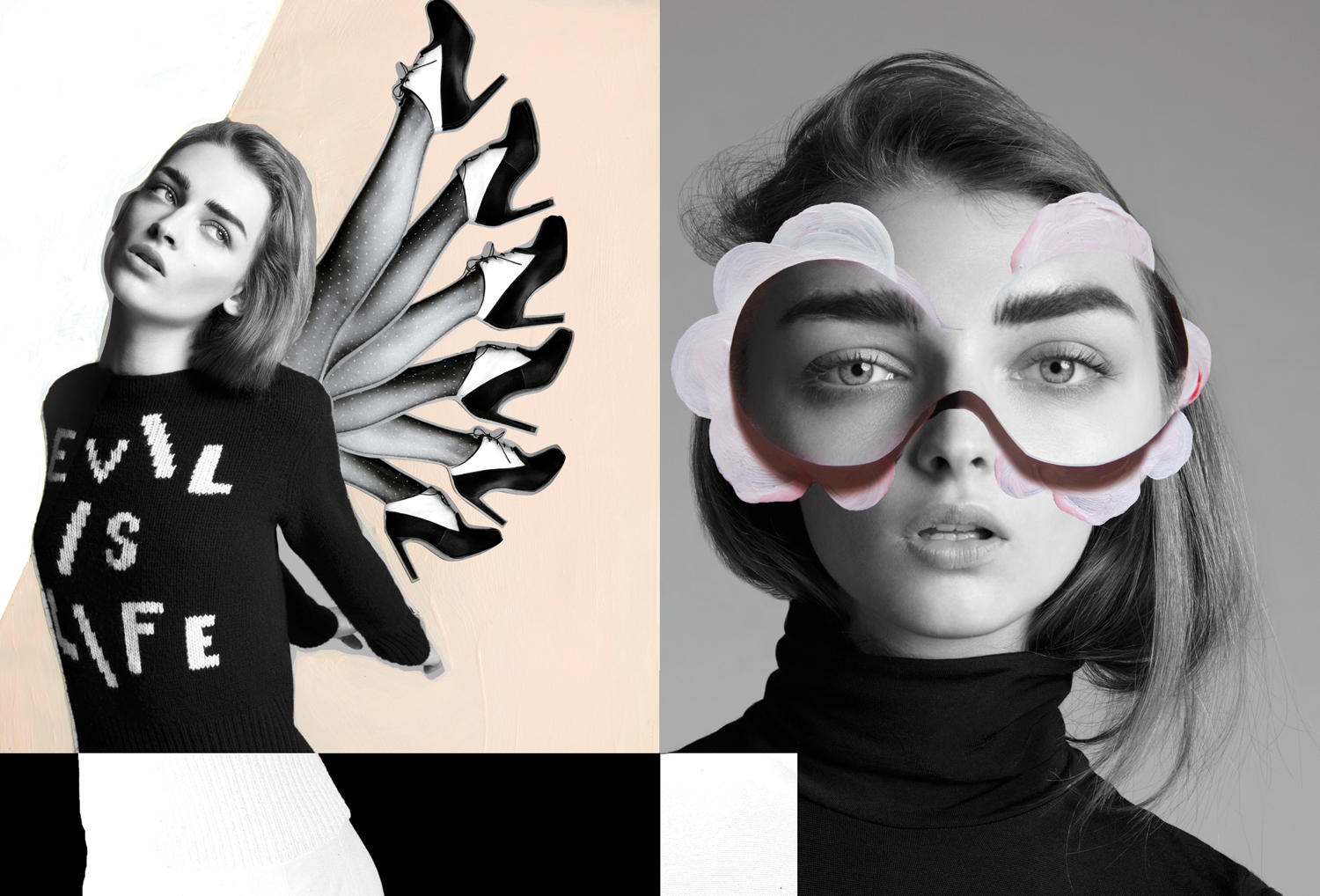Q&A: artist Quentin Jones
 Model, artist, illustrator, film-maker and Cambridge philosophy graduate are not often monikers that apply to a single person but they - and more, actually - form a summary of super-talented Quentin Jones. Jones’ distinctive graphic style incorporating surreal, graffiti-esque swirls, film and photomontage has taken the fashion world by storm. For Victoria Beckham, she created a jaunty short introducing the Victoria, Victoria Beckham line; for Chanel, a series of films featuring their dancing nail polishes. She’s created punk films for Vogue starring Cara Delevingne and massive billboards for Schweppes with Penelope Cruz. Her illustrations are now a part of the branded material of companies including Opening Ceremony and Marc Jacobs. Her eclecticism makes her work utterly current. Plus she has a cool boy’s name. No fair. This Wednesday, Quentin presents The Fractured and the Feline, a survey of works with spatial designer Robert Storey, Quentin’s most comprehensive show to date.
Model, artist, illustrator, film-maker and Cambridge philosophy graduate are not often monikers that apply to a single person but they - and more, actually - form a summary of super-talented Quentin Jones. Jones’ distinctive graphic style incorporating surreal, graffiti-esque swirls, film and photomontage has taken the fashion world by storm. For Victoria Beckham, she created a jaunty short introducing the Victoria, Victoria Beckham line; for Chanel, a series of films featuring their dancing nail polishes. She’s created punk films for Vogue starring Cara Delevingne and massive billboards for Schweppes with Penelope Cruz. Her illustrations are now a part of the branded material of companies including Opening Ceremony and Marc Jacobs. Her eclecticism makes her work utterly current. Plus she has a cool boy’s name. No fair. This Wednesday, Quentin presents The Fractured and the Feline, a survey of works with spatial designer Robert Storey, Quentin’s most comprehensive show to date.
Bel: Describe the intersection between art and fashion as it happens in your life? Quentin: I’d say that the intersection is between clothing/what I wear and how I work. I tend to dress for comfort and ease when I go to the studio. I have one shirt that gets more and more paint over it. That is the real intersection. But it raises the question of whether what we wear is really fashion.
Bel: Is fashion art? Quentin: Yes, so conversely to my answer above, I think fashion can be art - and it can also be one of the furthest things from it - much like creating visual work can be art at one end and commerce at the other, and also of course can be both. For fine art and fashion, the level of regard we hold it in depends on the process and intention of its creation.
Bel: What role does fashion play in your life? Quentin: Fashion for me is the everyday - and it is also a creative fantasy. I dress myself, I get very literally involved in fashion everyday, and more interestingly every time I dress for an event. It is my uniform, or can be my excuse to disguise or decorate myself. Then it is also something that exists on pages and I dream up how to show and edit together. It becomes an ingredient in my work. It is often the starting point to my pieces.
Bel: What did you learn from working with big league brands like Chanel and Victoria Beckham? Quentin: I have been pleased with the freedom they have given me to explore what their brand could be, even just for a few minutes online. I also learnt that the bigger the brand, the less fragile it is, and so more robust for creative collaboration.
Bel: Explain the process behind your short films. Quentin: Probably the usual mixture of understanding the brief, taking a moment to find references, trying to make sense of why you were drawn to a certain images and then sketching and designing specific ideas.
Bel: Where currently does your visual inspiration come from? Quentin: I keep a folder of references from the last few years that I update with every project. That is a very useful tool, but to find the new inspiration, I love to visit the Tate bookshop. I love flicking though old books and new magazines.
Bel: Which fine artists provide inspiration? Quentin: Jean Paul Goude, Motherwell, Matisse, the photographer Viviane Sassen....
Bel: What would you consider recurring motifs in your work? Quentin: Portraiture - the many ways I have and am interested in depicting a face. How much you can take away or add to a face, and it still counts as one. What inanimate objects can become characters with simple marks added in places. Why some splashes of paint suggest something that’s alive and another are just arbitrary marks.
Bel: Does your philosophy degree at Cambridge give your work a theoretical underpinning? Quentin: Having given my mind that training makes it easier to rationalise ideas. Thinking on my feet, and being able to bluff on the spot has proven very useful with work and dealing with client meetings. But, to an extent, you need the right sort of thought to start with to study philosophy. Otherwise, it would be torture. So perhaps if I had gone straight to art school, it would all have ended up the same way anyway - just two years sooner!
Bel: You also studied illustration at Central St Martins. What did you learn? Quentin: That I had a lot to catch up on! It made me ambitious and competitive again. I knew it was something I could work hard and do well in. I was just so far behind my classmates, having spent the previous three years not practising regularly. A lot of being talented as an artist is practice. You need to find a way to be fluent in your own visual language.
Bel: Do you set out to inspire, outrage or to challenge? Quentin: Of those three, I hope to inspire. If I outrage, it is by accident. I would never put something out there with the intention of offending. I hope most of what I do is for the sake of beauty, not horror. I doubt I challenge either. I’m just one of hundreds of artists who have worked in similar ways.
Bel: GIFs features in your work. What do you love about the technique? Quentin: Quite simply, because I love film, and I love making still images ... so it seemed only right that I should make still pictures that move a little. I also love that they loop; that your movement has a beginning, a middle and an end.
Bel: Of your work’s appeal, you said to net-a-porter: ‘We’re in such a clean, digital era ... I think people like to see something that feels handmade and raw.’ Quentin: That is still quite a good point. We are the generation driven by tech. In fact, my boyfriend develops tech ideas so it’s all I ever hear about - and I think everyone appreciates it if you can offer them a moment to stand back and see something real, to watch a video where you can feel how handmade it is ... despite it living on a site that has ads popping up based on your private emails! It’s nice to remember there are still individual hands working somewhere in all the cyber-noise.
Bel: How did your collaboration with Robert Storey work for this exhibition? Quentin: He was the obvious choice because we work so organically together. He is never horrified when I suggest dribbling paint down a beautiful clean structure he has made. It's kind of game on with him. I also trust his taste entirely and knew he would make the perfect interior for my work. I won't tell you too much but he has also created some genius twists with reflections, darkness and light.
Bel: You use yourself in your imagery. What is your intention behind this self-portraiture? Quentin: Self-portraiture is a nice exercise to revisit. It allows you to portray depths you may not otherwise be able to. And you can warp and disrespect your physical form without fear of offence. I also think that it will be a nice collection of projects in 25 years’ time, to see how the artist sees themselves changing.
The Fractured and the Feline: Quentin Jones with Robert Storey is presented by The Vinyl Factory at their space in The Brewer Street Car Park, London from November 19 November to December 2014 www.thevinylfactory.com

![Quentin Jones, Portraits from The Panama Legacy exhibition for Smythson [Bryan Ferry] 2013, collage, acrylic and ink on paper, 63 x 48cm, courtesy of the artist.](http://static1.squarespace.com/static/59d7e7c18fd4d21d6a4bf31f/5ac6a44dddff69fafe52be45/5ac6a4aaddff69fafe52c96e/1522967722687/featured-image-small.jpg?format=original)




